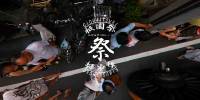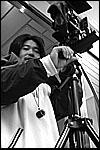
The Gion Festival Parade in 2005
Shinmachi-Street, Kyoto, Japan
July 17, 2005(12:39 local time)
© 2005 Sachio Izumi, All Rights Reserved.
The Gion Festival is one of the three major Japanese festivals of Yasaka Shrine. The Gion Festival has a long history and is known widely because of the magnificence of its parade, and the sacred rites on a large scale for one month.
Gion Festival was started in 869 A.D when a bad plague spread through Kyoto. In the first festival, young men carried numbers of wooden floats. They also erected 66 tall spears, representing the 66 provinces of Japan. It was a divine intervention to stop the plague. The plague soon ended, and this event became a popular festival.
The highlights of a festival are YOI-YAMA on the 16th and YAMAHOKO-JUNKOU on the 17th. YAMAHOKO-JUNKOU is the parade of colorful floats through downtown Kyoto. The floats are pulled through the streets by teams of men dressed in traditional costumes. There are two kinds of floats: YAMA and HOKO. YAMA are smaller floats (weight: 1.2-1.6 ton, height: about 6m) and carried by people on their shoulders. HOKO are giant floats (weight: 4.8-12 ton, height: about 25m) on large wooden wheels and pulled by people. There are 32 floats in the parade: 25 YAMA floats and 7 HOKO floats.
The most interesting thing to see during YAMAHOKO-JUNKOU is the turns of big floats at an intersection. They are hinged on blocks of wood to get them to turn at right angles. Men pulling the floats chant loudly, "Yoi, yoi, yoi-toh-sey!" accompanied with traditional Japanese music played by people who are on the second story of the two-story floats. In that way YAMA and HOKO enter into narrow Shinmachi Street from a main street. Shinmachi Street is particularly difficult for marches, but I can watch YAMA and HOKO nearby and am very impressed.
KIKUSUI-HOKO
The name of KIKUSUI-HOKO commemorates the well named KIKUSUI-IDO that existed in KONGOU-NOUGAKUDOU of the town. It met the boy who said "KIKUJIDOU" where it kept living for as many as 700 years, drinking the dew of a flower of the chrysanthemum when water that the envoy of the emperor in China of the great antiquity substituted for the medicine was visited and it entered the mountain.
Therefore. this float puts a life-size doll which symbolizes "KIKUJIDOU" and a shape like a chrysanthemum flower on the top of the float to wish anyone having eternal youth and longevity.
It is a characteristic that I attach 16 golden chrysanthemums and a sculpture of "KIKUJIDOU" which pointed to the sky to top of HOKO and decorate a roof plaque of a Chinese phoenix on a roof of a Chinese gable structure, and raise "SUIREN" and a called green bamboo blind in under the eaves. In the circumference of HOKO, a luxurious tapestry is given glory to. The pattern that a crane flies is drawn on the front of a tapestry, and, as for the side, a pattern of a peacock is drawn on a pattern of an artistic portrait of a lion, the back side.


 Tap or click the zoom icon in the bottom right corner of the picture to switch between in-page and fullscreen view
Tap or click the zoom icon in the bottom right corner of the picture to switch between in-page and fullscreen view